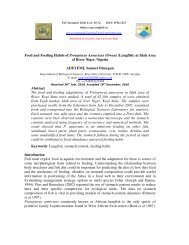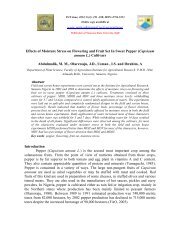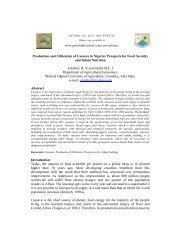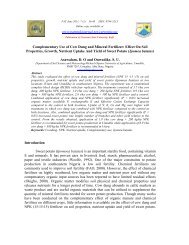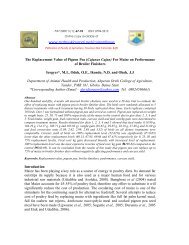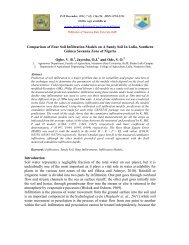Perceptions and Management Practices of Weaver Bird Pests in ...
Perceptions and Management Practices of Weaver Bird Pests in ...
Perceptions and Management Practices of Weaver Bird Pests in ...
Create successful ePaper yourself
Turn your PDF publications into a flip-book with our unique Google optimized e-Paper software.
PAT 2009; 5(1): 1-13 ISSN: 0794-5213; Bright et al; Farmers’ <strong>Perceptions</strong> <strong>and</strong> <strong>Management</strong> …….3adm<strong>in</strong>ister the questionnaires <strong>in</strong> the two villages. The data were analysed us<strong>in</strong>gdescriptive statistics presented as means, frequencies <strong>and</strong> percentages. .RESULTS AND DISCUSSIONFarmer socio-economic characteristics.About 19% <strong>of</strong> the respondents were below 30 years (young), 42% middle aged (31-50years) <strong>and</strong> 39% above 50 years (old) . All (100%) <strong>of</strong> the respondents were male <strong>and</strong>91% were married (Figure 1). Sixty three percent (63%) had non formal education <strong>and</strong>only 14% had attended secondary school. The respondents family size consisted <strong>of</strong>53% below 10 persons <strong>and</strong> all the respondents were farmers but only 79% belong t<strong>of</strong>armers organization. Farm size was ma<strong>in</strong>ly small hold<strong>in</strong>gs (3 acres <strong>and</strong> below) (54%).This is <strong>in</strong> agreement with some researchers that majority <strong>of</strong> Nigerian farmers are smallscale farmers with small farm hold<strong>in</strong>g (Alfred, 2000; Tologbonse, 2004)Farmers’ contact with extension agent <strong>and</strong> <strong>in</strong>formation sources.Visits by extension agents (90%) to the farmers were very encourag<strong>in</strong>g, <strong>and</strong> almost allrespondents had received advice on bird control (78.6%) from extension agent (Figure2). The extension agents had always (62%) visited the farmers <strong>and</strong> had been theirimportant source <strong>of</strong> advice (77.1%) on bird control (Table 1). Although advice had alsobeen received from fellow farmers (66%) <strong>and</strong> from parents (62%).About 45% rated radio as very important, <strong>and</strong> 88% rated newspaper as slightlyimportant while about 57% rated Extension Agents as very important (Table 2).However, the overall perception <strong>in</strong>dicated that all the sources <strong>of</strong> <strong>in</strong>formation namely;radio, television, neighbours, E.A <strong>and</strong> parent were important to the farmer exceptnewspaper (Table 2). This is <strong>in</strong> agreement with the f<strong>in</strong>d<strong>in</strong>gs <strong>of</strong> Tologbonse et al (2006).Farmer perceptions.Farmers perceptions were determ<strong>in</strong>ed from their vary<strong>in</strong>g op<strong>in</strong>ions expressed on series<strong>of</strong> specific questions. Ra<strong>in</strong>-fed lowl<strong>and</strong> rice was planted between July <strong>and</strong> August(70%), irrigated lowl<strong>and</strong> rice between June <strong>and</strong> July (68.2%) <strong>and</strong> upl<strong>and</strong> between May<strong>and</strong> June (91.7%) (Figure 2). Production Technologies publication by National CerealsResearch Institute Badeggi had recommended the month <strong>of</strong> June as sow<strong>in</strong>g time forupl<strong>and</strong> rice <strong>and</strong> July to August for lowl<strong>and</strong> rice. The farmers responses <strong>in</strong>dicated thatthey followed the recommended time <strong>of</strong> plant<strong>in</strong>g.<strong>Weaver</strong> bird was the most important pest <strong>of</strong> cultivated rice <strong>and</strong> all respondents couldrecognize the birds from the photographs shown to them (Table 3). Forty percent <strong>of</strong>farmers rated weaver bird as very serious pest while 86% op<strong>in</strong>ed that they <strong>in</strong>flicted
PAT 2009; 5(1): 1-13 ISSN: 0794-5213; Bright et al; Farmers’ <strong>Perceptions</strong> <strong>and</strong> <strong>Management</strong> …….4damage by remov<strong>in</strong>g rice from panicle (Table 3). All (100%) respondents <strong>in</strong>dicated thatweaver birds damage rice (Figure 3) feed<strong>in</strong>g on rice for food <strong>and</strong> about 82% said thatthe damage on rice reduced gra<strong>in</strong> yield considerably (Table 4). Human bird scarer wasthe most effective method <strong>of</strong> control (64.3%). It had rema<strong>in</strong>ed the most common (90%).The farmers also recognized the occurrences <strong>of</strong> rodents (98.6%), frogs (55.7%) <strong>and</strong>water ducks (1.4%) on rice fields. They were usually moderately serious pests (44.3%)but occasionally became serious (35.7%). The months <strong>of</strong> September to November(54.2%) <strong>and</strong> June to August (32.8%) were identified as period <strong>of</strong> severe damage.Research f<strong>in</strong>d<strong>in</strong>gs had <strong>in</strong>dicated that <strong>in</strong> Niger State, rodent caused rice crop losses thatranged from 19.8% to 46.9% (Bright <strong>and</strong> Ogunyemi, 2001a) Most farmers (77.1%)realized that some varieties <strong>of</strong> rice were more susceptible to bird damage. Our<strong>in</strong>vestigations have however shown that some morphological <strong>and</strong>/or physiological traits<strong>of</strong> the rice crop could reduce rodents <strong>and</strong> weaver birds damage (Bright, 2004). Othercontrol methods <strong>in</strong>cluded spread<strong>in</strong>g video tapes over the crop (14.3%), spread<strong>in</strong>g fishnet over the crop (10%), treat<strong>in</strong>g seeds with chemicals (12.9%) <strong>and</strong> erect<strong>in</strong>g a scarecrow(4.3%). Scare-crow was rather <strong>in</strong>efficient <strong>and</strong> uncommon <strong>in</strong> that it is <strong>of</strong>ten notmentioned <strong>in</strong> bird pest control. Many thought damage did not occur same time everyyear. Some op<strong>in</strong>ed that damage started dur<strong>in</strong>g October to December (46.3%). Most <strong>of</strong>the farmers <strong>in</strong>dicated that damage ended dur<strong>in</strong>g October to December (70.2%). Theyclaimed the birds were seen dur<strong>in</strong>g June to September (66%). Other farmers op<strong>in</strong>ed thatthe birds disappeared dur<strong>in</strong>g the months <strong>of</strong> January to March (Table 5). Clearly therewere major seasonal fluctuations <strong>in</strong> the study area that had been established by research(Bright <strong>and</strong> Ogunyemi, 2001b). The farmers appeared to have recognized thatobservable fact. More <strong>in</strong>teractions between research <strong>and</strong> <strong>in</strong>digenous knowledge arewarranted.Cost <strong>of</strong> control. Table 6 revealed that about 38% <strong>of</strong> the respondents reported that thecost description <strong>of</strong> birds was cheap 23% op<strong>in</strong>ed that it was costly. However, <strong>in</strong> terms <strong>of</strong>monetary value 43% spent below N5, 000 <strong>and</strong> 27% above N10, 000 to control birds ontheir rice field. This may be the situation with farmers who used their children to scarebirds on small farmsCONCLUSIONIn the study area, farmers identified weaver birds as a major pest <strong>of</strong> rice <strong>and</strong> applied anumber <strong>of</strong> physical <strong>and</strong> chemical methods. Guard<strong>in</strong>g, human scar<strong>in</strong>g which was usedmost by the farmers, def<strong>in</strong>itely consumed the time <strong>of</strong> their family. This was notprobably <strong>in</strong>cluded <strong>in</strong> their estimate cost<strong>in</strong>g <strong>of</strong> N5,000 <strong>and</strong> N10,000 control expenditure.There are <strong>in</strong>creas<strong>in</strong>g needs for effective environmentally safe, humane, <strong>and</strong> non-lethal
PAT 2009; 5(1): 1-13 ISSN: 0794-5213; Bright et al; Farmers’ <strong>Perceptions</strong> <strong>and</strong> <strong>Management</strong> …….5control techniques. Control methods can be <strong>in</strong>tegrated to provide vital environmentallysafe methods that would ease the economic burden <strong>of</strong> rice farmers. An array <strong>of</strong>complementary control methods such as; tim<strong>in</strong>g <strong>of</strong> plant<strong>in</strong>g to avoid bird damage,morphological traits <strong>of</strong> the crop that repel the birds, physical techniques like flash tapes<strong>and</strong> pesticides as a last resort are pest control strategies recommended <strong>and</strong> be<strong>in</strong>g reevaluated(Bright, 1995; Bright <strong>and</strong> Ogunyemi 2001b; Bright, 2004)REFERENCESAlfred, A. R. (2000). Banana <strong>and</strong> Planta<strong>in</strong> market<strong>in</strong>g activities among women <strong>in</strong> UrbanNsukka, Enugu State, Nigeria. In Olowu, T. A. (Ed) Agricultural Extension <strong>and</strong>Poverty Alleviation <strong>in</strong> Nigeria Proceed<strong>in</strong>gs <strong>of</strong> the 6 th Annual NationalConference <strong>of</strong> Agricultural Extension Society <strong>of</strong> Nigeria. Pp 31-40Bentley, J. W. (1992). The epistemology <strong>of</strong> plant protection: Honduran campes<strong>in</strong>oknowledge <strong>of</strong> pests <strong>and</strong> natural enemies. In R. W. Gibson <strong>and</strong> A. Sweetmore(eds) Proceed<strong>in</strong>gs <strong>of</strong> a Sem<strong>in</strong>ar on Crop Protection for Resource-Poor Farmer(Copenhagen: Technical Centre for Agricultural <strong>and</strong> Rural Cooperation/NaturalResource Institute), pp. 107-118.Bright, E.O. (1988). Species composition <strong>of</strong> weaver bird pests <strong>of</strong> rice <strong>in</strong> Badeggi, NigerState, Nigeria Int. Rice Res. Newsl. 13(6): 43.Bright, E.O. (1995). Aspects <strong>of</strong> ecology pest status <strong>and</strong> control <strong>of</strong> P. cucullatus Muller<strong>and</strong> Q. erythrops Hartlaub <strong>in</strong> the rice fields <strong>in</strong> Niger State, Nigeria. University<strong>of</strong> Ibadan M. Phil dissertation.Bright, E. O. & Ogunyemi. S. (2000). Diet <strong>and</strong> forag<strong>in</strong>g habits <strong>of</strong> village weaver birdPloceus cucullatus <strong>and</strong> red-headed quelea Quelea erythrops <strong>in</strong> rice fieldhabitats. Afr. J. Pl. Prot. 10: 71-81.Bright, E. O. & Ogunyemi. S. (2001a). The status <strong>of</strong> rodent pests <strong>in</strong> upl<strong>and</strong> <strong>and</strong> irrigatedlowl<strong>and</strong> rice fields <strong>in</strong> Badeggi, Niger State, Nigeria. Niger. J. <strong>of</strong> Pl. Prot. Vol.19:1-10Bright, E. O. <strong>and</strong> Ogunyemi. S. (2001b). Trends <strong>in</strong> major weaver bird numbers <strong>in</strong> therice fields <strong>of</strong> Badeggi, Niger State, Nigeria. In: Salako, F. K; S. T .O. Lagoke,A. B. J. A<strong>in</strong>a, D. Eruvbet<strong>in</strong> <strong>and</strong> O. A. Dipeolu (editors). Enhanc<strong>in</strong>gagriculturalresourcebase for youth development, <strong>in</strong>dustrial development <strong>and</strong> export.Proceed<strong>in</strong>gs <strong>of</strong> the 35 th Annual Conference <strong>of</strong> the Agricultural Society <strong>of</strong>Nigeria September 16-20, 2001 University <strong>of</strong> Agriculture, Abeokuta, NigeriaBright, E. O. (2004). Field comparison <strong>of</strong> <strong>in</strong>terspecific rice varieties <strong>and</strong> improvedsativas to damage by rodents <strong>and</strong> weaver birds. 3 rd Biennial Regional RiceResearch Review (4Rs 2004) Africa Rice Congress. Accra, Ghana 27-30September 2005
PAT 2009; 5(1): 1-13 ISSN: 0794-5213; Bright et al; Farmers’ <strong>Perceptions</strong> <strong>and</strong> <strong>Management</strong> …….6Bruggers, R.L. (1980). The situation <strong>of</strong> gra<strong>in</strong> eat<strong>in</strong>g birds <strong>in</strong> Somalia. Pp 5-16. In: Proc.9 th vertebr. Conf. Frenno, Carlifornia.Funmilayo, O. <strong>and</strong> Ak<strong>and</strong>e, M. (1974). The ecology economic impacts <strong>and</strong> control <strong>of</strong>vertebrate pests <strong>of</strong> upl<strong>and</strong> rice <strong>in</strong> the western state <strong>of</strong> Nigeria. Research Bullet<strong>in</strong>NO. 5, Institute <strong>of</strong> Agricultural Research <strong>and</strong> Tra<strong>in</strong><strong>in</strong>g. University <strong>of</strong> Ife, Ibadan.41pp.Heong, K. L. (1984). Pest control practices <strong>of</strong> rice farmers <strong>in</strong> Tanjung Karang,Malaysia. Insect Science <strong>and</strong> its Application, 5(3), 221-226.Heong, K. L. <strong>and</strong> Escalada, M. M. (1999). Quantify<strong>in</strong>g rice farmers pest managementdecision beliefs <strong>and</strong> subjective norms <strong>in</strong> stem borer control. Crop Protection18, 315-322.Manikowski, S. (1988). Arial spray<strong>in</strong>g <strong>of</strong> quelea. Tropical Pest <strong>Management</strong>, 34 (2):133-140.Misra , D. C. (1996). Monitor<strong>in</strong>g extension programmes <strong>and</strong> resources. In Swanson, B.E; Bentz, R. P. <strong>and</strong> S<strong>of</strong>ranko, A. J (ed) Improv<strong>in</strong>g Agricultural ExtensionManual FAO pp. 147-156.Park, P.O. (1974). Granivorous bird pests <strong>in</strong> Africa. Span. 17 (3): 126-12S<strong>in</strong>gh, B. N., S. Fagade, M. N. Ukwungwu, S. Williams, S. S. Jagtap, O. Oladimeji, A.Efisue <strong>and</strong> O. Okhidievbie, (1977). Rice grow<strong>in</strong>g environments <strong>and</strong> biophysicalconstra<strong>in</strong>ts <strong>in</strong> different agro ecological zones <strong>of</strong> Nigeria. Met. Journal 2 (1):35-44.Tologbonse, E. B. (2004). Adoption <strong>of</strong> improved rice technology by farmers <strong>in</strong> theInl<strong>and</strong> Valley Swamps <strong>of</strong> the Middle-Belt Zone <strong>of</strong> Nigeria. Unpublished Ph.DThesis submitted to the Department <strong>of</strong> Agricultural Extension <strong>and</strong> RuralDevelopment, University <strong>of</strong> Ibadan, Ibadan. 300ppTologbonse, E. B; Mes<strong>in</strong>i, O. <strong>and</strong> Tsado, J. H. (2006). Farmers perception <strong>of</strong> sources <strong>of</strong><strong>in</strong>formation <strong>in</strong> relation to adoption <strong>of</strong> improved rice production technology byfarmers <strong>in</strong> Inl<strong>and</strong> Valley Swamps <strong>of</strong> Middle Belt Zone, Nigeria. Journal OfAgricultural Extension. Vol. 9 pp 63-72
PAT 2009; 5(1): 1-13 ISSN: 0794-5213; Bright et al; Farmers’ <strong>Perceptions</strong> <strong>and</strong> <strong>Management</strong> …….7Source: field survey, 2005
PAT 2009; 5(1): 1-13 ISSN: 0794-5213; Bright et al; Farmers’ <strong>Perceptions</strong> <strong>and</strong> <strong>Management</strong> …….8Source: field survey, 2005
PAT 2009; 5(1): 1-13 ISSN: 0794-5213; Bright et al; Farmers’ <strong>Perceptions</strong> <strong>and</strong> <strong>Management</strong> …….9Source: field survey,2005
PAT 2009; 5(1): 1-13 ISSN: 0794-5213; Bright et al; Farmers’ <strong>Perceptions</strong> <strong>and</strong> <strong>Management</strong> …….10Table 1: Distribution <strong>of</strong> farmers by their contact with Extension.Variable Frequency %Received advice <strong>in</strong> bird control (n = 70)- Yes- NoEver visited by E. A. (n = 70)- Yes- NoDescription <strong>of</strong> Extension Agent’s visit (n =70)- Never- Rarely- Occasionally- Always551563726184478.621.490.010.02.98.625.762.9From whom advice on bird control ever received (n =70)Parent 44 62.86E. A. 54 77.14Farmer 42 66.0Source: field survey,2005Table 2: Distribution <strong>of</strong> farmers accord<strong>in</strong>g to perception <strong>of</strong> <strong>in</strong>formation sources.Rat<strong>in</strong>g <strong>of</strong> <strong>in</strong>formation sourcesInformationSourcesVeryImportantImportant SlightlyImportantNotImportantSumTotalMean OverallPerceptionRadio (n = 51) 23(45.1) 24(47.1) 4(7.8) _ 172 3.37 ImportantTV (n =18) 6(33.3) 8(44.7) 3(16.7) 1(5.6) 55 3.06 ImportantNeighbour/Friend 31(48.4) 33(51.6) - - 223 3.48 Important(n = 64)E. A (n = 51) 29(56.9) 18(35.3) 3(5.9) 1(2.0) 177 3.47 ImportantNewspaper (n = 8) - - 7(87.5) 1(12.5) 15 1.88 NotimportantParent (n = 48) 27(56.3) 20(41.7) 1(2.1) - 170 3.54 Important*Figures <strong>in</strong> parenthesis are %Source: field survey,2005
PAT 2009; 5(1): 1-13 ISSN: 0794-5213; Bright et al; Farmers’ <strong>Perceptions</strong> <strong>and</strong> <strong>Management</strong> …….11Table 3. Description <strong>of</strong> bird damage.Variable Frequency %<strong>Bird</strong> problem on farm at: (n =70)Plant<strong>in</strong>gAfter germ<strong>in</strong>ationMilkyMaturityHarvestAfter harvestCould identify bird that cause damageYesCould identify bird from PhotographYesSee bird every month <strong>of</strong> year (n =69)YesNoPart <strong>of</strong> rice crop damaged by identified birdsSeed/gra<strong>in</strong>sStage at which bird damage rice (n =70)Seed<strong>in</strong>gSeedl<strong>in</strong>gNursery bedTransplant<strong>in</strong>gFlower<strong>in</strong>gMilky*Type <strong>of</strong> damage perceived as more serious (n 70)Remov<strong>in</strong>g/pick<strong>in</strong>g planted seedTrampl<strong>in</strong>g on seedl<strong>in</strong>gRemov<strong>in</strong>g gra<strong>in</strong>s/seed from panicleWhy bird damage riceFeed on rice for food*Multiple responses. Source: field survey, 2005712125820147070234670145771164256607010.017.117.182.928.62010010033.366.7100207.1101015.791.435.78.5785.7100
PAT 2009; 5(1): 1-13 ISSN: 0794-5213; Bright et al; Farmers’ <strong>Perceptions</strong> <strong>and</strong> <strong>Management</strong> …….12Table 4: Perception <strong>of</strong> bird damage to rice farm.Variable Frequency %<strong>Bird</strong> damage on rice farm (n = 70)- Yes 70 100Frequency <strong>of</strong> bird damage (n = 70)- No losses <strong>in</strong> last 10yrs- Losses <strong>in</strong> 1-2 out <strong>of</strong> 10 yrs- Losses <strong>in</strong> 3 5 out <strong>of</strong> 10yrs- Losses every year*Effect <strong>of</strong> bird attack experiences on rice crop (n =70)- Reduce yield- Reduce harvest quality- Reduce <strong>in</strong>terest <strong>in</strong> rice production<strong>Bird</strong> attack occurrence (n 70)- Increase- Decrease- Same- Dont know6827295740362143248.5711.4338.541.4381.4357.1451.43Other animals damage (n = 70)Rat 69 98.6Frog 39 55.7Water duck (woshi-woshi) ` 2 2.9Moorhen (Bishengi) <strong>Bird</strong>sDescription <strong>of</strong> bird damage (n = 70)Very serious 28 40Serious 21 30.0Moderately serious 19 27.1Not serious 2 2.9Description <strong>of</strong> other animals damage (n =70)Very serious 12 17.1Serious 25 35.7Moderately serious 3 44.3Not serious 2 2.9Months <strong>of</strong> severe damage (n =70)JanJune AugSept NovDecVarieties more susceptible to bird damage (n =70)YesNoDamage same time yearly (n =67)YesNo<strong>Bird</strong> damage starts (n =69)June-JulyAug-SeptOct-Dec<strong>Bird</strong> damage ends (n =67)Jan-FebJune-AugOct-Dec*Multiple Response Source: field survey,200542338554162938181932182472.91.461.434.35.732.854.27.177.122.943.356.726.127.546.326.93.070.2
PAT 2009; 5(1): 1-13 ISSN: 0794-5213; Bright et al; Farmers’ <strong>Perceptions</strong> <strong>and</strong> <strong>Management</strong> …….13Table 5.Farmers’ perception <strong>of</strong> when weaver birds are seen <strong>and</strong> not seen.Variable Frequency %Months birds were seen (n =50)Jun-SeptOct-DecMonths birds were not seen (n = 49)Jan MarchJune AugNov DecSource: field survey, 2005331721424663442.98.249Table 6: Distribution <strong>of</strong> farmers accord<strong>in</strong>g to control strategies.Variables Freq. %<strong>Bird</strong> control methods used (n =70)*Human bird scarers (HS)Chemical poison on seeds (CS)Local concoctionsScare-crowNetVideo cassetteDescription <strong>of</strong> control methods <strong>in</strong> farmers’ locality (n =70)Very effectiveStop some damageDo little damageCost description (n=67)Very costlyCostlyModerately costlyCheapNo costCost <strong>of</strong> control (n = 70)Low (below N5,000)Medium (N 5,000 to N 10,000)High (above N 10,000)* Multiple responseSource: field survey, 20056392371040282115625203021199012.92.94.31014.357.140.02.91.522.49.037.329.942.930.027.1



